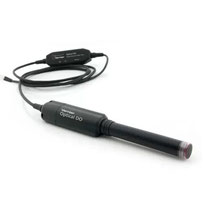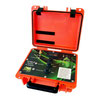Dissolved Oxygen O2 Sensors
We offer both optical and polarographic dissolved oxygen sensors manufactured by Qubit Systems. The complete and competitively priced dissolved oxygen Q-OX1LP package, and the individual polarographic dissolved O2 electrodes are particularly useful for studying respiration in small submerged organs (e.g. roots), isolated cells, or microorganisms. For larger aquatic organisms that use intermittent flow respiration, e.g. the Q-Box AQUA aquatic respiration package uses an optical dissolved oxygen probe.
Q-OX1LP Dissolved Oxygen Measurement and Experimentation System

Q-OX1LP Dissolved Oxygen Package, using a polarographic dissolved oxygen electrode and is designed for measuring photosynthesis and/or respiration in the aqueous phase. The instrument can be employed with suspensions of plant cells, animals, organelles (such as chloroplasts and mitochondria), submerged roots, and algae. Additionally, the Q-OX1LP is well-suited for monitoring any chemical and biochemical reactions that involve the production or consumption of oxygen in the aqueous phase. The Dissolved O2 Package is inclusive of all necessary instruments, accessories, software, data acquisition interface, and manuals, catering to both researchers and students alike.
- Continue reading on the OX1LP
-
The OX1LP Dissolved Oxygen Packages offer a range of DO electrodes with varying volumes, starting from 1 ml up to 50 ml. The O2 electrode, housed in a water-jacketed cuvette, is suitable for measuring O2 consumption (or production) in biological samples or enzymatic reactions. Calibration is a straightforward 2-point process, with all necessary calibration accessories included in the package. With an outstanding accuracy and a resolution of 0.03% O2 (based on air-saturated water = 100%; Clark type), the Dissolved Oxygen Package allows for flexible expression of Dissolved O2 values in desired units such as mg L-1, % dissolved O2, ppm, etc., through a simple calibration procedure. The electrodes have a fast response time (15 s). The water jacket facilitates calibrations and experiments at consistent temperatures; for measurements at different temperatures a convenient correction can be applied using the included software.
Q-OX1LP O2 Analysis Package - Features
- Polarographic Oxygen Electrode System
- Outstanding accuracy and resolution
- Different volume cuvette available (1, 2.5, 4, 6, 30, 50 ml)
- rapid response time (15 s)
- Water jacketed cuvette allows temperature control with optional, circular laboratory water bath
- All accessories and software included
- Easy to fit and calibrate
| Components | Q-OX1LP Dissolved Oxygen Analyzer System | OPEN | ||||||||||||||||||||||||||||||||||||||||||||||||||||||||||||||||||||||||
|
Table 1: Components of the Q-OX1LP Dissolved Oxygen Analyser System. Please note that the System is available with differently sized cuvettes - the max. volume of the electrode is indicated while the minimum volume is 1/6 of the maximum.
|
||||||||||||||||||||||||||||||||||||||||||||||||||||||||||||||||||||||||||
| References | Dissolved Oxygen Electrodes | OPEN |
|
||
Dissolved Oxygen Cuvette Electrode (Clark-type)

Dissolved oxygen (DO) cuvette electrodes, DO systems use a polarographic sensing system to measure the production or consumption of dissolved oxygen in liquid suspension. The DO cuvette electrode consists of a water-jacketed cuvette, a removable base containing the electrode and a plunger. These electrodes are available in different volumes: 1, 2.5, 4, 6, 30 and 50 ml, with a 100 µl volume flow-through cuvette also available. The DOCE use a Clark cell type dissolved oxygen detector capable of detecting changes as low as 0.03% O2 in water saturated with 100% air, holding a rapid response time of 15 seconds. Electrodes are used in conjunction with the Q-A231 Electrode Amplifier, Q-A255 Magnetic Stirrer, Q-C610 Data Interface and Q-C901 Software. They are essential components of the Q-OX1LP Dissolved Oxygen package (see above).
| Types/Models | Dissolved Oxygen Cuvette Sizes / Materials | OPEN | ||||||||||||||||||||||||||
|
The following DO cuvette electrodes are available, the maximum volume of the electrode is indicated. The minimum volume is 1/6 of the maximum and can be achieved by lowering the plunger into the sample chamber.
|
||||||||||||||||||||||||||||
Q-S122 Optical Measurement of Dissolved O2

Q-S122 Optical Dissolved Oxygen Probe. Using luminescence technology, Qubit's optical dissolved oxygen (DO) probe provides fast, easy and accurate measurements of dissolved oxygen in solutions. The versatile Q-S122 probe is well suited for both laboratory and field measurements of dissolved O2 and offers advantages such as no warm-up time, infrequent calibration, no solution to fill, and no stirring. The Q-S122 optical DO probe is a key component of the Q-AQUA aquatic respirometry package and the Qubit DO water control system. With built-in temperature and pressure compensation, it can record DO in % saturation or mg L-1. Submersible up to 5 feet (~1.5 m) with an optional guard for protection and weighting, this probe is recommended for use with the Q-C610 LabQuest Mini data interface and Q-C901 LoggerPro software, or independently with the LabQuest3 data acquisition system. Applications of the Q-S122 DO probe include aquatic respiration, environmental monitoring incl. aquaculture, and water control tasks.
Optical O2 Sensor Q-S122 - Features
- Luminescence technology
- Easy to use
- No warm up required
- Infrequent calibration
- No filling solutions required
- No stirring required
| Specifications | Optical O2 Probe Q-S122 | OPEN |
|
Range: 0 to 20 mg L-1 (or ppm), 0 to 100% |
||
Overview - Methods to measure dissolved Oxygen
- Several methods have been developed to measure dissolved oxygen in water / liquid samples, each with its own advantages and limitations. Among the key methodologies are: Continue reading
-
- Winkler method: The Winkler method is a classic titration-based technique. It involves the addition of reagents to a water sample to convert dissolved oxygen to a measurable form. Titration determines the amount of reagent consumed, indirectly indicating the concentration of dissolved oxygen.
- Membrane electrode method: This method uses a dissolved oxygen probe equipped with a semi-permeable membrane. The membrane selectively allows oxygen to diffuse through, creating a potential difference. This potential is then measured, providing a direct reading of the dissolved oxygen concentration.
- Chemiluminescence: Chemiluminescent methods involve the reaction of dissolved oxygen with a specific reagent, resulting in the emission of light. The intensity of the light emitted is proportional to the concentration of dissolved oxygen, allowing accurate measurements.
- Optical sensors: Optical sensors work on the principle of fluorescence or luminescence. A sensor shines light into the water sample and the amount of light absorbed or emitted by oxygen-sensitive compounds is measured. This provides a rapid and continuous assessment of dissolved oxygen levels.
- Amperometric sensors: Amperometric sensors measure the current generated when oxygen reacts with an electrode. The current is proportional to the oxygen concentration in the sample, providing real-time monitoring capabilities.
- Mass spectrometry: Mass spectrometry involves the ionisation and analysis of oxygen molecules. Although it provides highly accurate results, it is typically used in research settings due to its complexity and cost.
The choice of method depends on factors such as the required accuracy, sample size and the presence of interfering substances. See below for selected references on oxygen measurement techniques.
| References | Methods Dissolved Oxygen Measurements | OPEN |
|
||
For measurements of dissolved CO2 in liquids / suspensions, the
Q-DCO2 System is available in 2+ configurations (standard/rapid).
The Q-AQUA Aquatic Respirometry Package, using the DO probe described above, is designed for measurements inside aquatic respirometry chambers.
The Q-ACS Aquatic Control System allows the independent monitoring and control of dissolved oxygen in up to 4 water tanks.
If you are interested in O2 in the gas phase and not in liquid media, consider the gas-phase O2 sensors.







